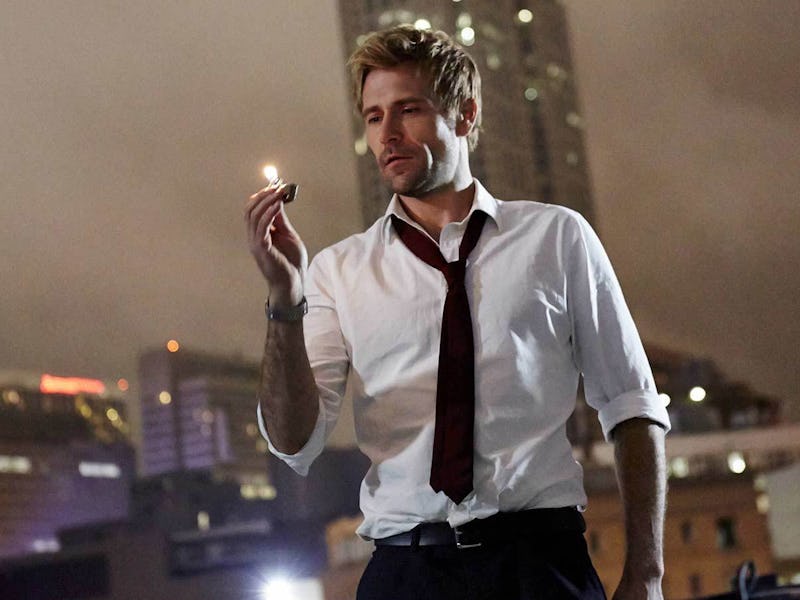Superhero Magic in 'Wonder Woman' And 'Doctor Strange'
Doctor Strange isn't the first magician in comic book pages.

What role does magic play in the realm of superheroes? Doesn’t the existence of super-people in capes who can fly and lift boulders render a classic definition of “magic” useless? Not really.
Magic is alive and well in the various superhero universes, and the ability to conjure spells and sorceries is often treated as a special power apart from super abilities. It’s why characters like Marvel’s Doctor Strange and DC’s Zatanna are often involved in stories that take part in “other realms” of their respective universes. Magic is about to matter, for instance, to Marvel films in a big way.
It would be more fair to say that comic books co-opted magic for their stories. In 1944, Marvel Comics simply brought into the fold Merlin from Arthurian legend for their comic Young Allies #11. Presumably, that move set the stage for Marvel to introduce a whole variety of mythical characters like King Arthur and Morgan le Fay, and actual sorceress adapted from the Arthurian character of the same name.
With the introduction of Thor and other Nordic mythical figures in 1962, the Marvel Universe featured magical beings as an established faction within all the science and technology aspects of Iron Man and The Hulk. A line from the first Thor film mentions that in Asgard, “Technology and magic are one and the same.” This was an attempt to modernize the very real magical context of the Marvel universe.
Thor
Doctor Strange was introduced a year later, along with several, we’ll say orientalist, takes on magic, including his teacher The Ancient One, an old Tibetan mystic. It’s fair to say that the magical world and technological world lived side-by-side but mostly dealt with their own spheres.
However, mutants like Scarlet Witch and Magik further blur the line between the powers classified as magical, and those classified as mutations. It’s incredibly confusing to chart which powers Scarlet Witch has that are a result of her mutant experimentation, as opposed to those related to sorcery, although her powers as a “reality-warper” sometimes acts as a catch-all. She did inadvertently rid the world of mutants in the House of M story arc.
Throw in other mystic forces like Dormammu, who is somehow both a magical being and a cosmic one, and the whole division of magic and space powers all sort of blend together into an inseparable concoction of magic, technology, and mutant powers.
Wonder Woman
DC Comics chart a similar course, first by introducing Doctor Fate in 1940, who gains his powers through an ancient, magical helmet. However, the magical aspects of the DC universe explodes in 1941, with the wider Greek and Roman pantheon of gods, alongside Wonder Woman. By bringing in figures like Aries and Zeus, DC Comics also brought in mythical sorcerers like Circe as a primary villain for Wonder Woman. Like the Nordic gods from Marvel’s Thor, this allowed DC to play around with a heavily mythical element in their universe, bringing in magic as justified by historical legends.
Since then, DC Comics introduced characters like Zatanna in 1964 who is unrelated to the larger mythical branches of Wonder Woman, but brings with her an urban, underground society of magical users. Constantine’s introduction in 1985 for DC imprint Vertigo allowed for a heavy use of religious themes to be incorporated with magical mysticism. The publisher even introduced Lucifer from western Christian mythology to go along with the existence of heaven and hell as physical realms in the DC universe.
Vertigo also launched Neil Gaiman’s Sandman in 1989 which relies heavily on atmospheric, magical realms. While separate from the main DC universe, many DC characters like Martian Manhunter, Etrigan the Demon, Scarecrow from Batman, and John Constantine all made cameos in Sandman hinting at some connection between the two universes.
Based on these instances, it’s clear that the evolution of magic in Marvel and DC comics originated from building upon pre-existing myths and legends. At least for the most part. While original characters have come and gone, it’s not a stretch to say that it’s thanks to some solid foundations rooted in known legends that helped form some sort of basis for magic in the two popular comic universes.
Zatanna #1 Cover by Brian Bolland
There is, of course, the fun of seeing characters like Wonder Woman and Batman face off against the Roman god of war, but there’s also fun in knowing that Nordic gods like Thor and Loki are actually just aliens from another planet. The difference between Marvel and DC appears to be that while Marvel has mostly merged their the sci-fi aspects of their universe with magic, DC has kept its mysticism defined, more or less, as straight-forward magic.
The big test to see how Marvel and DC interprets their magical universes for the big screen will be in 2016’s Doctor Strange film, and next year’s Wonder Woman. Both films are strong basis for their respective comic universe’s magical aspects and it will be interesting to see how they merge into the larger cinematic universes.